 Multitrunk Trees, Woody Vines, and Other Forms
Multitrunk Trees, Woody Vines, and Other Forms
On March 14, 2010 The Eastern Native Tree
Society and Western Native Tree Society switched from discussion
lists on Google Groups to a new discussion list in a Bulletin Board
format at:
http://www.ents-bbs.org/index.php Posts made since the
inception of the BBS on march 14, 2010 will be sorted and archived
on the BBS. Click on the link above to go to the equivalent section
on the new BBS. This website will continue to serve as a front end
for the ENTS and WNTS groups. It will continue to serve as a
repository of older posts, and will serve as the host site for
special projects and features that are not well suited for a BBS
format. Please visit the BBs for the latest information and trip
reports.
Multitrunk Trees, Woody Vines, and Other Forms
by Edward Forrest Frank, December 2007
Introduction
Most trees fall into the simple category of single trunk
trees. Through the years guidelines for measuring trees have
focused on this basic form. However, this is not the only
growth form that trees may have. A second form that is
commonly found are trees with multiple stems. these multitrunk
trees can be considered in many ways to be a cluster of individuals
trees that happen to be close together. However since they
share a common central root system, and canopy space, in other ways
they are not fully two or more individual trees, and not something that cannot be considered
just a single large organism. Considering
how to define and differentiate trees with this form form led to the
creation of several more categories of tree forms, some of which are
infrequent, but not unusual, and some that are simply odd.
Clonal coppices and groves are an example of an infrequent
form. This growth form is exhibited by only a limited number
of tree species, but examples of these forms can cover hundreds of
acres of land. These tree forms grow by send out subterranean roots which sprout
new trunks. The individual trunks can be considered as
individual single trunk trees, but the group because of the way they
have grown, and the interconnectivity of the root systems, past and
present can in some ways be considered a group organism. So I
have offered some suggestions on characterizing these
colonies. The odd forms include those forms that grew because
of unusual circumstances that affected the tree, or those trees that
simply have an unusual growth form not seen in most other tree
species. The breakdowns I have proposed is presented in more
detail below. I don't expect people to suddenly change their
focus from big and tall trees to multitrunk tree and other forms,
but I feel it is important to have a framework in place for
consideration of these forms. It is often difficult to
distinguish a tree with two or more fused trunks with a single trunk
tree. The investigator should use their best judgment about
whether a tree has a single trunk or is a multitrunk tree, and not
try to be liberal or conservative in their interpretation as this
would introduce subjective bias in the data set.
Edward Frank
Categories of Tree Forms
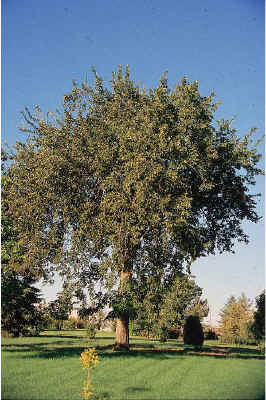
Single Trunk American Elm |

Scarlet Oak, MI |
Category 1: Single Trunk Tree: This is the standard
growth form of most trees consisting of a single large trunk growing
from a simple root mass below ground. A single trunk tree is
defined as one that has a single pith at ground level.
Measurements for this form are defined by the Tree Measuring
Guidelines of the Eastern Native Tree Society by Will Blozan. It
should be noted that if the tree branches below 4.5 feet, then the
girth is measured at the narrowest point below the lower branching.
It has been common practice among foresters to define a forked
tree as one that branches below 4.5’ above root collar, and to
take measurement of both forks above swelling. This is not
part of the standard ENTS and American Forests protocol, but is a
reasonable alternative measurement standard that I would encourage
people to adopt. Sometimes, especially in open areas, small
sucker shoots may grow around the base of larger trees. These
are not considered as multiple stems as they tend to be very small
and short lived.
|
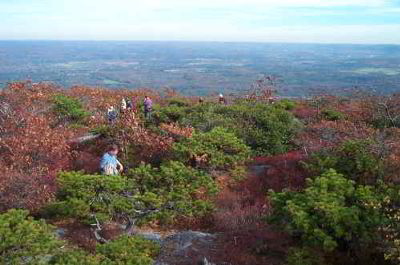
Stunted pines atop Mt. Everett, MA |
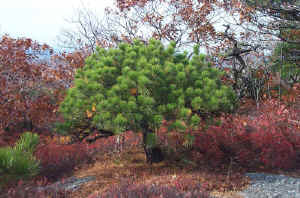
Stunted pine atop Mt. Everett, MA |

Hickory Rune State park, PA |
- Small sized trees and shrubs: Shrubs have been described
by some definitions as smaller woody plants with multiple stems
at ground level. Many shrubs however, when they are of
larger size, will have a single stem at ground level that can be
measured using the criteria for trees in general. I
think there needs to be standards for measuring trees overall so
that different measurements from different areas can be
compared. What I am looking at in this regard is that if
you use the measurement standard of the narrowest point on the
trunk below the first branching, and you are looking at a forest
of stunted trees, such as are shown growing atop Mt. Greylock,
then each tree will be measured at a different height, because
they all surely branch below 4.5 feet. Establishing a
standard low measurement point for short or stunted
specimens smaller than some value would allow better comparisons
of these small dwarfed trees or other trees and shrubs of
smaller size between each other. They could also be
measured at 4.5 feet, but what does that really tell us about
the tree? The scale of measurement needs to be appropriate
to whatever it is you are trying to measure. I am all for
standardization, but not in favor of blindly following an
inappropriate standard.
I am proposing measurements at 9" and 15" for
trees and shrubs less than 20 feet tall as the initial low
measurement points for these small specimens.
- Low Branching or Forking Trees
When you propose a classification system there often may be
revisions needed upon further reflection and input from others. I
recently proposed an organizing structure for measuring multitrunk
trees and odd growth forms. One item that needs to be revisited is
the idea of low branching trees. Pines and hemlocks typically do not
stump sprout, but in areas that have been cut they are often
represented by low forking trees that split just above ground level.
As they grow these two stems grow into a single massive trunk. Dale
Luthringer in his Cook Forest dataset refers to these as
"doubles", meaning low forking trees, not multiple trunks
that have grown together. Don Bertolette commented that it has been
common practice among foresters to define a "forked tree"
as one that branches below 4.5' above root collar, and to take
measurement of both forks above swelling. When the tree is small it
is easy to differentiate the branches from the main trunk. These can
be measured using the standard single stem protocol in which the
girth is measured at the narrowest point below the branching or
forking and the height noted. However when these branches or forks
grow larger they merge into a larger mass in which the individual
branches and forks can not be measured or separated. Theoretically
these trees should be measured at the narrowest point below 4.5 feet
and the height noted, as they are by definition a single stem tree
with a single pith at ground level. However as this measurement
incorporates not only the main trunk, but the girth of the
branches/forks as well these girths are exaggerated with respect to
simple single trunk trees. For that reason they are generally put
aside in a separate no-mans-land category in which they are neither
multitrunk or single trunk trees. I propose these be considered a
special sub-class of single trunk trees. Their girth should be
measured at the narrowest point below the fork or branching with the
height of measurement noted, at 4.5 feet, and if possible at any
point 4.5 feet or above at which the individual stems or branches
can be separately measured and that height noted. This should be the
new protocol whether or not the individual branches can be separated
or not. In other words this should apply to both smaller and larger
examples of low branching trees. For listing purposes, these can be
considered as a separate category or included in the multitrunk
listings for size comparisons. For American Forest listings, their
criteria requires simple the narrowest measurement below 4.5 feet as
the girth of the tree.I would strongly encourage that digital photos
of any of the odd tree forms be taken to accompany the
measurements to better illustrate exactly waht was measured. For
low branching trees we should also add 1) height of the lowest
branch, 2) list whether the lower girth measurement is made on a
single discrete stem, or whether it is a girth that includes
merged branch, fork and trunk wood. See: Low
Branching or Forking Trees
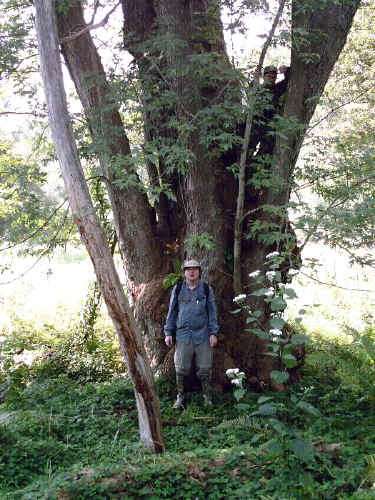
Multitrunk Silver maple, King Island, ARIW, PA |
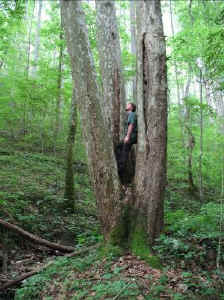
158'+ triple-stemmed sycamore, Baxter Creek, GSMNP
|
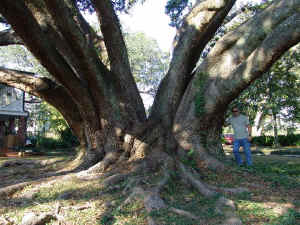
Seven Sisters Live Oak, LA |
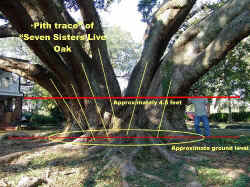
Pith of the trunks forming the Seven Sisters - diagram by
Will Blozan |
Category 2: Multitrunk Trees This is the second
largest category of tree forms. These are trees and shrubs
that have more than one stem growing from a single root mass. these
trees have a fused base area that consist of multiple piths at
ground level, These generally form when the original stem of
the tree was damaged, broken, or browsed by animals, damaged
from falling (natural or man-caused) This results in new stem
sprouting from the root mass. In general these stems are all
of similar age and size, but will often reduce to developing one, or
a few dominant stems. Trees commonly growing in flood
plains, such as Silver Maple and Willow, are often are damaged
during floods and this may be the most common growth form of the
species. Trees growing as second growth forest after timbering
operations also have a higher than normal incidence of
multiple trunk trees due to damage of small trees during the
operation and from stump sprouts. The different stems of these
multi-trunked trees often flair outward. The fused base should
be measured at a height of 4.5 feet, if it extends that high, or
measured at the narrowest point below 4.5 feet when it does not
extend that high. The number of individual stems making
up the measured girth should be noted, in addition any stems not
included in the girth measurement should also be noted. Where
possible the girth of the largest single stem should be measured at
4.5 feet or at whatever height it becomes separate from the
multi-trunk mass for comparison with single trunk trees. Optionally
the girth and height of each individual stem making up the
multitrunk tree can be measured. The height of the tallest
stem, and the crown spread of the multi-trunk mass should also
be measured. A website from Great Britain http://www.treeregister.org/measuringtrees.shtml
is the first site I have found that tries to define how to measure
multi-trunk trees, although I am not following their protocol.
It should be noted that stems developing from a very large stump,
will have a very large hollow in the center that will falsely
inflate a 4.5’ height girth measurement. This situation
should be noted.
|

Silver maple multitrunk clump on King Island, ARIW, PA |
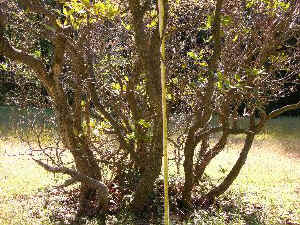
Mountain laurel multitrunk clump, PA
|
- Multitrunk Clump: This is a number of individual trunks
growing from a central root mass. It may incorporate a multitrunk
tree as well as individual stems that have not been incorporated
into the multitrunk tree. Over time a series of closely
packed individual stem may fuse into a multitrunk tree, while
other stems will be lost through stem exclusion. These differ
from a clonal coppice in that the trunks in a coppice tend to
sprout from lateral roots extending from the central mass rather
than from the central root mass itself. A closely packed series
of trunks can be considered a multitrunk clump, if they are not
one of the limited number of species that sprout stems
from lateral roots. The trunks in the multitrunk clump
tend to be similar in age and size. Shrubs often grow in
this form with a series of stems/trunks growing from the central
root mass. To characterize these forms, at a minimum the
girth and height of the largest stem, the canopy spread of the
entire clump, and the number of significant stems, in the
judgment of the investigator, in the clump should be
noted. If these shrubs or trees are short or dwarfed
specimens, the lower measurement points suggested above, at
9" and 15", should be used in addition to the standard
girth measurement at 4.5 feet.

Staghorn Sumac Clonal Coppice, Cook Forest State Park,
PA
|
Category 3: Clonal Coppice Some tree species form coppices in
which the initial tree sends out lateral root branches, or rhizomes,
and new tree stems sprout from these lateral roots. This
process continues and the result is a clonal cluster of trees
derived from a single original tree. Common examples of these
coppices include the mound-like sumac colonies and rhododendron
patches. This spreading by roots is not the only method of
propagation for these colonies, as they also produce seeds. It
may be difficult or impossible to distinguish whether something is a
clonal coppice, or simply a cluster of individual trees growing
close to each other based upon simple observation alone. However
there are some clues that can be used. In a clonal coppice the trees
typically are oldest in the center and younger toward the edges.
Also if the species is sexually dimorphous, meaning that there
are distinct differences between the male and female fruiting bodies
and that the individual trees are either male or female, if it is a
clonal coppice all of trees will be of the same sex. If they
are of different sexes, then it is a cluster of different trees.
In a clonal coppice, the largest individual tree should be
measured for comparison with single trunk trees. In addition
the number of stem in the coppice should be counted, and the area of
the coppice should be noted. See: Clonal
Coppices

Aspen Clonal Colony |

Aspen Clonal Colony |
Category 4: Clonal Colonies This in many ways is the
same process as described for clonal coppices, but on a far larger
scale. The primary type example of a clonal colony is the
aspen. Wikipedia http://en.wikipedia.org/wiki/Aspen
says: All the aspens (including White Poplar) typically grow
in large colonies derived from a single seedling, and spreading by
means of root suckers; new stems in the colony may appear at up to
30-40 m from the parent tree. Each tree only lives for 40-150 years
above ground, but the root system of the colony is long-lived, in
some cases for many thousands of years, sending up new trunks as the
older trunks die off above ground. For this reason it is considered
to be an indicator of ancient woodlands. Some aspen colonies become
very large with time, spreading about a metre per year, eventually
covering many hectares. They are able to survive intense forest
fires as the roots are below the heat of the fire, with new sprouts
growing after the fire is out. The Pando colony in Utah
contains an estimated 47,000 stems and occupies 107 acres. The shear
scale of these colonies suggests to me that they are not only
quantitatively different from the simple clonal coppice, but
represent a fundamentally different class of growth form. In
the case of these clonal colonies, again if the species is sexually
dimorphous, and most aspens and poplars are dimorphous, all of trees
in the colony will be of the same sex. In addition they will
typically all change colors in the fall, and sprout leaves in the
spring at the same time. For measurements purposes, the
largest individual specimens should be measured for comparison with
single trunk trees, the area of the colony should be mapped, and the
number of individual stems in the colony estimated.
Oddball Categories

A fusion of a
chestnut oak and a white oak. These adjacent trees were not just
rubbing and callused but actually fused together. The top of the
white oak (smaller stem in the photos) was dead but the grafted
section was alive. Photo by Will Blozan, Winding Stair section,
GSMNP.
|
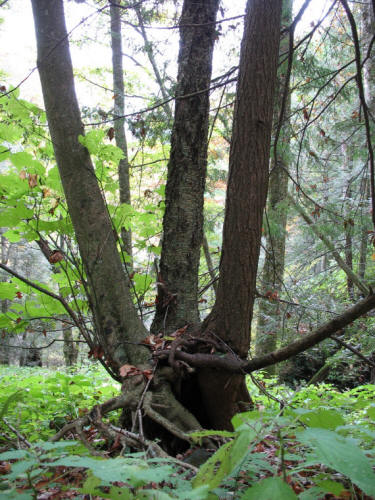
A
striped maple, a yellow birch, and an eastern hemlock
germinated out of the same rotting stump and all have
survived. -Jess Riddle
These are clearly three separate trees, but their
juxtaposition makes them a candidate for this category in the
future should they all survive |
Category 5: Fused and Hugging Trees Sometimes two trees may
grow to large size adjacent to each other and grow together. These
may be of the same species or even trees of two different genera or
families. These
consist of two basic forms: a)Fused trees are two trees that have become
grafted together. Generally this grafting is between two trees
of the same or closely related species or genera. (see
Inosculation:
http://en.wikipedia.org/wiki/Inosculation ) These are also
sometime called Comjoined Trees; and b) Hugging - two trees
that are not grafted together, but are physically touching. rubbing,
intertwined, or entangled. These need to be considered on a
case by case basis. In general the standard height, girth, and
crown spread measurements can be made for each individual of the
conjoined or hugging pair.
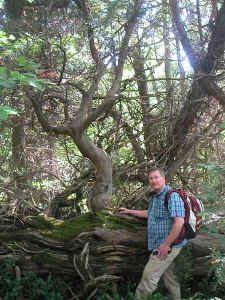 |
South
Manitou Island, MI One of the most amazing finds here was
that of this ancient fallen cedar that was actually still
alive. At first sight we thought that this was a nurse log
supporting a young cedar tree. But that young cedar turned out
to be a limb of the fallen tree! In fact, two of the limbs of
the fallen giant were still producing foliage and growing
vertically up towards the sunlight from their gnarled bases -
E. Ostuno |
Category 6: Fallen Trees There are cases where an
individual tree has fallen, from wind events or other causes. On
these fallen trees the upright branches form new vertical trunks,
and roots may sprout from the surface of the tree where it touches
the ground. These are unusual and should be considered on a
case by case basis. Jess Riddle wrote: "I most
often see smooth barked species in floodplains forming new trunks
after falling. In Congaree National Park, American holly and
ironwood commonly produce vertical shoots after falling."
Lee frelich reports: "Black spruce also does this.
On very rare occasions white pine and balsam fir can do it, but
apparently only in boreal forests with deep moss. I have seen
hemlock spread out like a carpet across the forest floor in the
snow forest in the Porcupine Mountains, MI, after saplings
were knocked over by heavy snow accumulation, but am not sure if its
rooted in places other than the original trunk. The willows in
MN floodplains (black willow, peach leaf willow) sometimes also turn
into a row of trees after blowing over." Don Bertolette
noted: "They very seldom attain much size, as the
connection to the roots usually negates effective nutrient/moisture
transport mechanisms. Several species in the west do this, and
extremes do occur, but seldom larger than normal
structure." These are unusual specimens and no standard
protocol for documenting them would be workable. They need to
be considered on a case by case basis.
Category 7: Tree Complexes Lee Frelich described some
white cedar growing in swales in the Door Peninsula of Wisconsin:
"Many ancient white cedars line the swales, and many more
are fallen into the swales, but remain alive, with the individual
branches turning upright to become new trees, which then blow down a
few hundred years later in many directions, and their branches
become trees as well, the whole tangle a historical puzzle that may
be hundreds or even a thousand or more years old. I call these cedar
complexes. Sometimes it isn't even clear if they (genetically) are
one tree; if another tree falls across a downed cedar, it can graft
to the other tree." Situations such as this where there
are a tangled mass of trees, re-sprouting, grafting, and other
processes can have no better name than a complex. They need to
be documented on a case by case basis.

Banyan tree in front of the Old Lee County Courthouse in
Fort Myers, Florida. Photo by Wknight94. |
Category 8: Banyan-Like Trees There are several examples of
this tree planted as an exotic in the United States. http://www.panoramas.dk/fullscreen7/f23-banyan-tree.html
It is a member of the fig family. http://www.haryana-online.com/Flora/barh.htm
"(Ficus bengalensis), a remarkable tree of India and tropical
Africa sends down from its branches great numbers of shoots, which
take root and become new trunks. A single tree thus may spread over
a large area and look like a small forest. This tree, belonging to
the family Moraceae, is considered to be sacred in some places in
India. A specimen in the Calcutta botanical garden is more
than 100 years old. It has a main trunk 13 feet (4 m) in diameter,
230 trunks as large as oak trees, and more than 3,000 smaller ones.
The largest banyan tree known is on the island of Sri Lanka. It has
350 large trunks and over 3,000 small ones. The banyan often grows
to a height of over 21 meters and lives through many ages. "
I would consider this to include any tree that produces
multiple trunks through the growth of aerial roots that grow to form
new trunks.
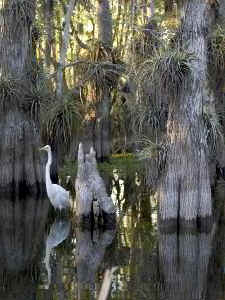
Bald Cypress with cypress knee and Great Egret, Everglades
National park, FL - photo by NPS
|
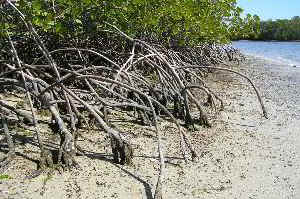
Mangrove roots, Everglades National Park, FL. - photo by NPS
|
Category 9: Mangroves and other trees with large
aerial roots. No protocol has yet been defined. Options
might include documenting the spread of the aerial roots and their
height. For Bald Cypress noting the distance from the trunk of
the cypress knees and their size.

"Big Cedar" along
highway in Olympic National Park, WA. This tree is
described in Bob Van Pelt's book "Forest Giants of the
Pacific Coast" as the Kalaloch Cedar. It is
measured at 123 feet high, and 19.6 feet in diameter.
Several large epiphytic hemlocks grow atop this tree.
One is directly above me in the photo - Photo by Ed Frank |
Category 10: Epiphytic Trees: In general these are
not unique in any way aside from their placement in the branches or
canopy of other trees.
Woody Vines
Woody vines are generally considered to be a plant that contains woody material but does not stand upright on its own, They tend to climb on the branches and trunks of other plants. There are many of them in the Northeast and Eastern Untied States. Prominent in the woods around PA are Grape Vines, Virginia
Creeper, and Poison Ivy. ENTS periodically measure the girth of some of these. Jess Riddle has reported Grape Vines with girths of 4 feet in the southern US.
In one report on the Ocanaluftee Basin of GSMNP, Jess Riddle
commented: "Grape vines, often over four inches in diameter, frequently tie together all of the canopy layers,
and may be accompanied by Duthcman's pipe vine.

Epworth-by-the-Sea, St. Simons Island, GA , a 4'9" cbh
grape vine growing on a live oak. - photo by Jess Riddle |
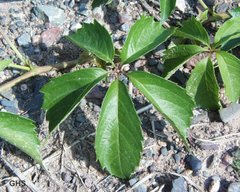
Virginia Creeper |
How should these be measured? Where possible try to find the rooted end and measure the girth 4.5 feet from the end of the vine, and the obvious thickening at branching points should also be avoided.
If the rooted end is not located a measurement anywhere along the
length of the vine will suffice. There is very little data on Grape
(Vitus sp.) and other vine species. The are significant as secondary species in many of our woods. They can a a major component in may area, as most of you know who have ever tried to work their way through a grape thicket. Will Blozan reports that "The “tallest” species I have encountered are Virginia creeper and Dutchman’s pipe, both over 120’. I recorded VA creeper at 130.5 feet in one of the Tsuga Search trees I
climbed." In one report on the Ocanaluftee Basin of GSMNP,
Jess Riddle commented: "Grape vines, often over four inches in diameter, frequently tie together all of the canopy layers,
and may be accompanied by Duthcman's pipe vine.
--- Woody Vines Section ---more----
Index of Older Posts:
|